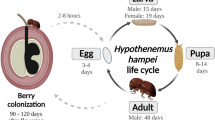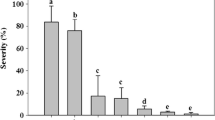Abstract
The coffee berry borer Hypothenemus hampei (Ferrari) (Coleoptera: Scolytidae) has been a threat to coffee (Coffea arabica; Coffea robusta) (Rubiales: Rubiaceae) production for hundreds of years, causing farmers all over the world lose of money. Consequently, the continuous use of synthetic chemicals to control this insect has caused great harm to the environment, human beings, and the ecosystem. In this regard, the study aimed to elucidate the possibility of using integrated pest management that employs Beauveria bassiana (Hypocreales: Cordycipitaceae), CMU-C1 lure modified traps, and botanically derived insecticides from tobacco short stems to control coffee berry borer. Interestingly, the results showed that, when B. bassiana was applied to infested coffee cherries, it caused 100% insect mortality within 3 months when performed by an increasing number of insects. However, those in untreated control recorded no dead insects. Luckily, when B. bassiana was combined with up to 25% of Nicotiana tabacum short stem suspension, it caused no effect on the spore germination of B. bassiana. Conversely, the number of insects in the treatment with tobacco short stem applied to infested berries was not different from the untreated control. Observably, three years of field trials resulted in a decreased insect population in the coffee field that was applied with B. bassiana, and tobacco short stem suspension combined with CMU-C1 lures trap. B. bassiana and CMU-C1 lures combined trap is a very useful tool for controlling Hypothenemus hampei with several advantages such as eco-friendliness, low cost, target specificity, and next generation insecticide for insect pest control.





Similar content being viewed by others
Data availability
When the request is made to the corresponding authors, the data will be sent to them.
References
Afandhi A, Pratiwi VR, Hadi MS, Setiawan Y, Puspitarini RD (2020) Suitable combination between Beauveria bassiana (Balsamo) vuillemin and four. J Agric Sci 42(2):341–349. https://doi.org/10.17503/agrivita.v42i2.2678
Ali S, Farooqi MA, Sajjad A, Ullah MI, Qureshi AK, Siddique B, Asghar A (2018) Compatibility of entomopathogenic fungi and botanical extracts against the wheat aphid, Sitobion avenae (Fab.) (Hemiptera: Aphididae). Egypt J Biol Pest Control 28(1):4–9. https://doi.org/10.1186/s41938-018-0101-9
Angkasith P (2001) Coffee production status and potential of organic arabica coffee in Thailand *. First Asian Regional Round-Table on Sustainable, Organic and Speciality Coffee Production, Processing and Marketing 26–28
Asfaw E, Mendesil E, Mohammed A (2019) Altitude and coffee production systems influence extent of infestation and bean damage by the coffee berry borer. Arch Phytopathol Pflanzenschutz 52(1–2):170–183. https://doi.org/10.1080/03235408.2019.1594541
Benavides P, Bustillo A, Góngora C (2012) IPM program to control coffee berry borer Hypothenemus hampei , with emphasis on highly pathogenic mixed strains of Beauveria bassiana , to overcome insecticide resistance in Colombia. Insecticides – Adv Integr Pest Manag 511–540
Bilal H, Hassan SA, Khan IA (2012) Isolation and efficacy of entomopathogenic fungus (Metarhizium anisopliae) for the control of Aedes albopictus Skuse larvae: suspected dengue vector in Pakistan. Asian Pac J Trop Biomed 2(4):298–300. https://doi.org/10.1016/S2221-1691(12)60026-4
Depieri RA, Martinez SS, Menezes AO Jr (2005) Compatibility of the fungus Beauveria bassiana (Bals.) Vuill. (Deuteromycetes) with extracts of neem seeds and leaves and the emulsible oil. Neotrop Entomol 34(4):601–606. https://doi.org/10.1590/S1519-566X2005000400010
Feng MG, Poprawski TJ, Khachatourians GG (1994) Production, formulation and application of the entomopathogenic fungus Beauveria bassiana for insect control: current status. Biocontrol Sci Technol 4(1):3–34
Greco EB, Wright MG, Burgueño J, Jaronski ST (2018) Efficacy of Beauveria bassiana applications on coffee berry borer across an elevation gradient in Hawaii. Biocontrol Sci Technol 28(11):995–1013. https://doi.org/10.1080/09583157.2018.1493088
Harnprasertpongse N, Sangdee C (2014) Caffeine reduces risk of Parkinson’s disease. Thai J Pharmacol 36(1):45–62
Infante F (2018) Pest management strategies against the coffee berry borer (Coleoptera: Curculionidae: Scolytinae). J Agric Food Chem 66:5275–5280. https://doi.org/10.1021/acs.jafc.7b04875
Infante F, Jaramillo J, Castillo A, Vega F (2009) The coffee berry borer, Hypothenemus hampei (Ferrari) (Coleoptera: Curculionidae): a short review, with recent findings and future research directions. Terr Arthropod Rev 2(2):129–147. https://doi.org/10.1163/187498209X12525675906031
Jaramillo J, Bustillo AE, Montoya EC, Borgemeister C (2005) Biological control of the coffee berry borer Hypothenemus hampei (Coleoptera: Curculionidae) by Phymastichus coffea (Hymenoptera: Eulophidae) in Colombia. Bull Entomol Res 95(5):467–472. https://doi.org/10.5376/mpb.2012.03.0007
Khan S, Guo L, Maimaiti Y, Mijit M, Qiu D (2012) Entomopathogenic fungi as microbial biocontrol agent. Mol Plant Breed 3(7):63–79. https://doi.org/10.5376/mpb.2012.03.0007
Kumar KK, Sridhar J, Murali-baskaran RK, Senthil-nathan S, Kaushal P, Dara SK, Arthurs S (2019) Microbial biopesticides for insect pest management in India : Current status and future prospects. J Invertebr Pathol 165:74–81. https://doi.org/10.1016/j.jip.2018.10.008
Mascarin GM, Jaronski ST (2016) The production and uses of Beauveria bassiana as a microbial insecticide The production and uses of Beauveria bassiana as a microbial insecticide. World J Microbiol Biotechnol 31(11):177. https://doi.org/10.1007/s11274-016-21313
Morris JR, Vandermeer J, Perfecto I (2015) Biological control of the coffee berry borer under varying pest densities. PLoS ONE 10(11):1–15. https://doi.org/10.1371/journal.pone.0142850
Mugo HM (2009) The coffee berry borer, Hypothenemus hampei Ferrari (Coleoptera: Scolytidae) in Eastern Africa region: the extent of spread, damage and management systems. Available online at: http://www.ico.org/event_pdfs/cbb/presentations/Kimenia%20Mugo%20CBB-%20ICO%20Paper.pdf. (Accessed 20 Oct 2020)
Pérez J, Infante F, Vega FE (2015) A coffee berry borer (Coleoptera : Curculionidae : Scolytinae) bibliography. J Insect Sci 15(1):14–17. https://doi.org/10.1093/jisesa/iev053
Puff C, Chamchumroon V (2003) Non-indigenous Rubiaceae grown in Thailand. Thai Forest Bull. Bot 31:75–94
Puripattanavong J, Songkram C, Lomlim L, Amnuaikit T (2013) Development of concentrated emulsion containing Nicotiana tabacum extract for use as pesticide. J Appl Pharm Sci 3(11):16–21. https://doi.org/10.7324/JAPS.2013.31104
Rajula J, Rahman A, Krutmuang P (2020) Entomopathogenic fungi in Southeast Asia and Africa and their possible adoption in biological control. Biol Control. https://doi.org/10.1016/j.biocontrol.2020.104399
Vivekanandhan P, Kannan S, Alford L, Pittarate S, Geedi R, Elangovan D, Marimuthu R, Krutmuang P (2023b) First report on the enzymatic and immune response of Metarhizium majus bag formulated conidia against Spodoptera frugiperda: An ecofriendly microbial insecticide. Front Microbiol 14
Vivekanandhan P, Kavitha T, Karthi S, Senthil-Nathan S, Shivakumar MS (2018) Toxicity of Beauveria bassiana-28 mycelial extracts on larvae of Culex quinquefasciatus mosquito (Diptera: Culicidae). Int J Environ Res Public Health 15(3):440
Vivekanandhan P, Swathy K, Alford L, Pittarate S, Subala SPRR, Mekchay S, Elangovan D, Krutmuang P (2022a) Toxicity of Metarhizium flavoviride conidia virulence against Spodoptera litura (Lepidoptera: Noctuidae) and its impact on physiological and biochemical activities. Sci Rep 12(1):16775
Vivekanandhan P, Swathy K, Bedini S, Shivakumar MS (2023a) Bioprospecting of Metarhizium anisopliae derived crude extract: A ecofriendly insecticide against insect pest. Int J Trop Insect Sci 1–12
Vivekanandhan P, Swathy K, Murugan AC, Krutmuang P (2022d) Insecticidal efficacy of Metarhizium anisopliae derived chemical constituents against disease-vector mosquitoes. J Fungi 8(3):300
Vivekanandhan P, Swathy K, Shivakumar MS (2022b) Stability of insecticidal molecule aucubin and their toxicity on Anopheles stephensi, Aedes aegypti, Culex quinquefasciatus and Artemia salina. Int J Trop Insect Sci 1–15
Vivekanandhan P, Swathy K, Shivakumar MS (2022c) Identification of insecticidal molecule aucubin from Metarhizium anisopliae ethyl acetate crude extract against disease mosquito vector. Int J Trop Insect Sci 1–16
Vivekanandhan P, Thendralmanikandan A, Kweka EJ, Mahande AM (2021) Resistance to temephos in Anopheles stephensi larvae is associated with increased cytochrome P450 and α-esterase genes overexpression. Int J Trop Insect Sci 41:2543–2548
Waller JM (1985) Control of coffee diseases. Coffee 219–229. Springer, Boston, MA. https://doi.org/10.1007/978-1-4615-6657-19
Wathanakun MP (2016) A Study of factors influencing choice of coffee beans used by independent coffee shops. Doctoral dissertation, Thammasat University
Wiryadiputra S, Cilas C, Morin JP (2009) Effectiveness of the brocap trap in controlling the coffee berry borer (Hypothenemus hampei Ferr.) in Indonesia. In 22nd International Conference on Coffee Science, ASIC 2008, Campinas, SP, Brazil, 14–19 September, 2008, 1405–1408. Association Scientifique Internationale du Café (ASIC)
Acknowledgements
We would like to express our gratitude to Chiang Mai University for providing a portion of the funding for this study.
Author information
Authors and Affiliations
Contributions
P.K, J.R and M.T conceived this research idea and standardize the experimental procedures. P.K, J.R, S.P, Y.C, V.P, L.A, and M.T performed bioassays and wrote the draft. L.A. assisted in the editing of the English language. J. R., V.P., and S.P. looked after the insect cultures and assisted with MS preparation.
Corresponding authors
Ethics declarations
Conflict of interest
There is no potential conflict of interest to disclose on the part of the authors.
Additional information
Publisher's Note
Springer Nature remains neutral with regard to jurisdictional claims in published maps and institutional affiliations.
Rights and permissions
Springer Nature or its licensor (e.g. a society or other partner) holds exclusive rights to this article under a publishing agreement with the author(s) or other rightsholder(s); author self-archiving of the accepted manuscript version of this article is solely governed by the terms of such publishing agreement and applicable law.
About this article
Cite this article
Krutmuang, P., Rajula, J., Pittarate, S. et al. Biocontrol efficacy of Beauveria bassiana in combination with tobacco short stem and modified lure traps. Int J Trop Insect Sci 43, 1591–1600 (2023). https://doi.org/10.1007/s42690-023-01063-x
Received:
Accepted:
Published:
Issue Date:
DOI: https://doi.org/10.1007/s42690-023-01063-x




